[1] 罗盛飞,胡志波,王宁华,等.原发性膝骨关节炎易感基因多态性位点的系统综述[J].中国康复理论与实践,2022,28(7):803-808.
[2] DRIBAN JB, HARKEY MS, BARBE MF, et al. Risk factors and the natural history of accelerated knee osteoarthritis: a narrative review. BMC Musculoskelet Disord. 2020;21(1):332.
[3] PEREIRA D, PELETEIRO B, ARAÚJO J, et al. The effect of osteoarthritis definition on prevalence and incidence estimates: a systematic review. Osteoarthritis Cartilage. 2011;19(11):1270-1285.
[4] CHEN H, WU J, WANG Z, et al. Trends and patterns of knee osteoarthritis in China: a longitudinal study of 17.7 million adults from 2008 to 2017. Int J Environ Res Public Health. 2021;18(16):8864.
[5] ACKERMAN IN, KEMP JL, CROSSLEY KM, et al. Hip and knee osteoarthritis affects younger people, too. J Orthop Sports Phys Ther. 2017;47(2):67-79.
[6] KATZ JN, ARANT KR, LOESER RF. Diagnosis and treatment of hip and knee osteoarthritis: a review. JAMA. 2021; 325(6):568-578.
[7] BLAGOJEVIC M, JINKS C, JEFFERY A, et al. Risk factors for onset of osteoarthritis of the knee in older adults: a systematic review and meta-analysis. Osteoarthritis Cartilage. 2010;18(1):24-33.
[8] SIMIC M, HARMER AR, AGALIOTIS M, et al. Clinical risk factors associated with radiographic osteoarthritis progression among people with knee pain: a longitudinal study. Arthritis Res Ther. 2021;23(1):160.
[9] HUANG XM, YUAN FZ, CHEN YR, et al. Physical therapy and orthopaedic equipment-induced reduction in the biomechanical risk factors related to knee osteoarthritis: a systematic review and Bayesian network meta-analysis of randomised controlled trials. BMJ Open. 2022;12(2):e051608.
[10] 汤雨婷,安丙辰,郑洁皎.膝骨关节炎生物力学参数的研究进展[J].中国康复理论与实践, 2020,26(12):1417-1421.
[11] SHARMA L, HURWITZ DE, THONAR EJ, et al. Knee adduction moment, serum hyaluronan level, and disease severity in medial tibiofemoral osteoarthritis. Arthritis Rheum. 1998;41(7):1233-1240.
[12] BENNELL KL, BOWLES KA, WANG Y, et al. Higher dynamic medial knee load predicts greater cartilage loss over 12 months in medial knee osteoarthritis. Ann Rheum Dis. 2011;70(10): 1770-1774.
[13] KROHN K. Footwear alterations and bracing as treatments for knee osteoarthritis. Curr Opin Rheumatol. 2005;17(5):653-656.
[14] SHULL P, LURIE K, SHIN M, et al. Haptic gait retraining for knee osteoarthritis treatment. Haptics Symposium. IEEE. 2010;25-26:409-416.
[15] SCHACHE AG, FREGLY BJ, CROSSLEY KM, et al. The effect of gait modification on the external knee adduction moment is reference frame dependent. Clin Biomech (Bristol, Avon). 2008;23(5):601-608.
[16] FREGLY BJ, REINBOLT JA, ROONEY KL, et al. Design of patient-specific gait modifications for knee osteoarthritis rehabilitation. IEEE Trans Biomed Eng. 2007;54(9):1687-1695.
[17] WANG S, MO S, CHUNG RCK, et al. How foot progression angle affects knee adduction moment and angular impulse in patients with and without medial knee osteoarthritis: a meta-analysis. Arthritis Care Res (Hoboken). 2021;73(12):1763-1776.
[18] DE CAMPOS D, SHOKUR S, DE LIMA-PARDINI AC, et al. Kinematics predictors of spatiotemporal parameters during gait differ by age in healthy individuals. Gait Posture. 2022;96(7):216-220.
[19] MOHER D, LIBERATI A, TETZLAFF J, et al. Preferred reporting items for systematic reviews and meta-analyses: the PRISMA statement. PLoS Med. 2009;6(7):e1000097.
[20] BELLAMY N. Validation study of WOMAC: a health status instrument for measuring clinically important patient relevant outcome to antirheumatic drug therapy in patients with osteoarthritis of the hip and knee. J Rheumatol. 1988;15(1):1833-1840.
[21] NOMA H, NAGASHIMA K, KATO S, et al. Meta-analysis using flexible random-effects distribution models. J Epidemiol. 2022;32(10):441-448.
[22] CALDWELL LK, LAUBACH LL, BARRIOS JA. Effect of specific gait modifications on medial knee loading, metabolic cost and perception of task difficulty. Clin Biomech (Bristol, Avon). 2013; 28(6):649-654.
[23] CUI W, WANG C, CHEN W, et al. Effects of toe-out and toe-in gaits on lower-extremity kinematics, dynamics, and electromyography. Appl Sci. 2019; 9(23):1-22.
[24] GUO M, AXE MJ, MANAL K. The influence of foot progression angle on the knee adduction moment during walking and stair climbing in pain free individuals with knee osteoarthritis. Gait Posture. 2007;26(3):436-441.
[25] HUNT MA, CHARLTON JM, KROWCHUK NM, et al. Clinical and biomechanical changes following a 4-month toe-out gait modification program for people with medial knee osteoarthritis: a randomized controlled trial. Osteoarthritis Cartilage. 2018;26(7):903-911.
[26] HUNT MA, TAKACS J. Effects of a 10-week toe-out gait modification intervention in people with medial knee osteoarthritis: a pilot, feasibility study. Osteoarthritis Cartilage. 2014;22(7):904-911.
[27] JENKYN TR, HUNT MA, JONES IC, et al. Toe-out gait in patients with knee osteoarthritis partially transforms external knee adduction moment into flexion moment during early stance phase of gait: a tri-planar kinetic mechanism. J Biomech. 2008;41(2):276-283.
[28] KHAN SJ, KHAN SS, USMAN J, et al. Combined effects of knee brace, laterally wedged insoles, and toe-out gait on knee adduction moment and fall risk in moderate medial knee osteoarthritis patients. Prosthet Orthot Int. 2019;43(2):148-157.
[29] KHAN SJ, KHAN SS, USMAN J, et al. Combined effects of knee brace, laterally wedged insoles and toe-in gait on knee adduction moment and balance in moderate medial knee osteoarthritis patients. Gait Posture. 2018;61(3):243-249.
[30] KHAN SS, KHAN SJ, USMAN J. Effects of toe-out and toe-in gait with varying walking speeds on knee joint mechanics and lower limb energetics. Gait Posture. 2017;53(3):185-192.
[31] LYNN SK, COSTIGAN PA. Effect of foot rotation on knee kinetics and hamstring activation in older adults with and without signs of knee osteoarthritis. Clin Biomech (Bristol, Avon). 2008; 23(6):779-786.
[32] LYNN SK, KAJAKS T, COSTIGAN PA. The effect of internal and external foot rotation on the adduction moment and lateral-medial shear force at the knee during gait. J Sci Med Sport. 2008;11(5):444-451.
[33] OGAYA S, NAITO H, IWATA A, et al. Toe-Out Gait Decreases the Second Peak of the Medial Knee Contact Force. J Appl Biomech. 2015;31(4):275-280.
[34] SHULL PB, SHULTZ R, SILDER A, et al. Toe-in gait reduces the first peak knee adduction moment in patients with medial compartment knee osteoarthritis. J Biomech. 2013;46(1):122-128.
[35] SIMIC M, WRIGLEY TV, HINMAN RS, et al. Altering foot progression angle in people with medial knee osteoarthritis: the effects of varying toe-in and toe-out angles are mediated by pain and malalignment. Osteoarthritis Cartilage. 2013;21(9):1272-1280.
[36] TOKUNAGA K, NAKAI Y, MATSUMOTO R, et al. Effect of foot progression angle and lateral wedge insole on a reduction in knee adduction moment. J Appl Biomech. 2016;32(5):454-461.
[37] UHLRICH SD, SILDER A, BEAUPRE GS,
et al. Subject-specific toe-in or toe-out gait modifications reduce the larger knee adduction moment peak more than a non-personalized approach. J Biomech. 2018;66(1):103-110.
[38] ULRICH B, HOFFMANN L, JOLLES BM, et al. Changes in ambulatory knee adduction moment with lateral wedge insoles differ with respect to the natural foot progression angle. J Biomech. 2020;103(4):109655.
[39] BIRMINGHAM TB, MARRIOTT KA, LEITCH KM, et al. Association between knee load and pain: within-patient, between-knees, case-control study in patients with knee osteoarthritis. Arthritis Care Res (Hoboken). 2019;71(5):647-650.
[40] D’SOUZA N, CHARLTON J, GRAYSON J, et al. Are biomechanics during gait associated with the structural disease onset and progression of lower limb osteoarthritis? A systematic review and meta-analysis. Osteoarthritis Cartilage. 2022;30(3):381-394.
[41] SIMIC M, HINMAN RS, WRIGLEY TV, et al. Gait modification strategies for altering medial knee joint load: a systematic review. Arthritis Care Res (Hoboken). 2011;63(3):405-426.
[42] WANG S, CHAN KHC, LAM RHM, et al. Effects of foot progression angle adjustment on external knee adduction moment and knee adduction angular impulse during stair ascent and descent. Hum Mov Sci. 2019;64(4):213-220.
[43] GOLDRING MB, OTERO M. Inflammation in osteoarthritis. Curr Opin Rheumatol. 2011;23(5): 471-478.
[44] IRSIK, SARAH. The effect of toe-in/toe-out variation on locomotion: a comprehensive review. Boone: Appalachian State University. 2017.
[45] ROELKER SA, KOEHN RR, CARUTHERS EJ, et al. Effects of age and knee osteoarthritis on the modular control of walking: a pilot study. PLoS One. 2021;16(12):e0261862.
[46] LEE HJ, CHOU LS. Balance control during stair negotiation in older adults. J Biomech. 2007; 40(11):2530-2536.
[47] HUNT MA, SIMIC M, HINMAN RS, et al. Feasibility of a gait retraining strategy for reducing knee joint loading: increased trunk lean guided by real-time biofeedback. J Biomech. 2011;44(5):943-947.
[48] LYNN SK, REID SM, COSTIGAN PA. The influence of gait pattern on signs of knee osteoarthritis in older adults over a 5-11 year follow-up period: a case study analysis. Knee. 2007;14(1):22-28.
[49] HART HF, BIRMINGHAM TB, PRIMEAU CA, et al. Associations between cadence and knee loading in patients with knee osteoarthritis. Arthritis Care Res (Hoboken). 2021;73(11):1667-1671.
[50] WALLACE IJ, WORTHINGTON S, FELSON DT, et al. Knee osteoarthritis has doubled in prevalence since the mid-20th century. Proc Natl Acad Sci U S A. 2017;114(35):9332-9336.
|
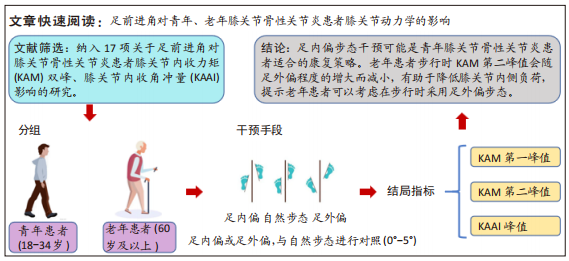
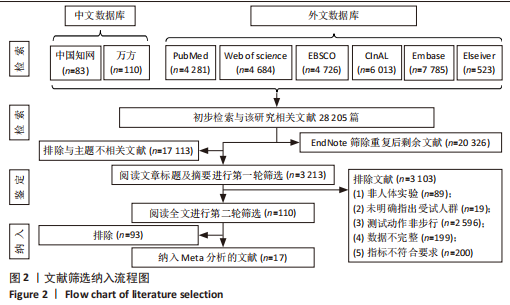

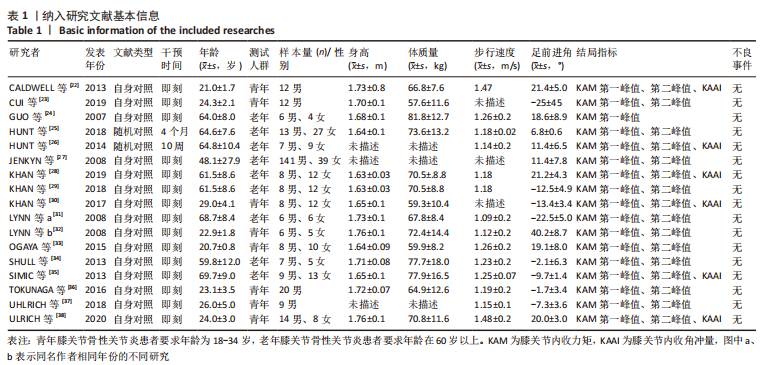

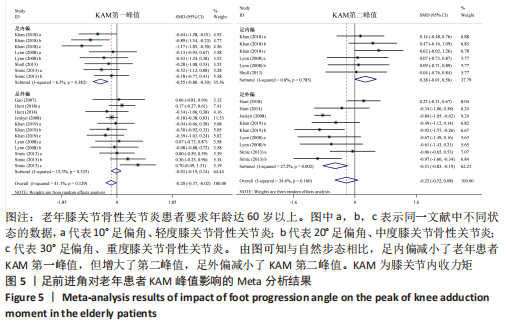
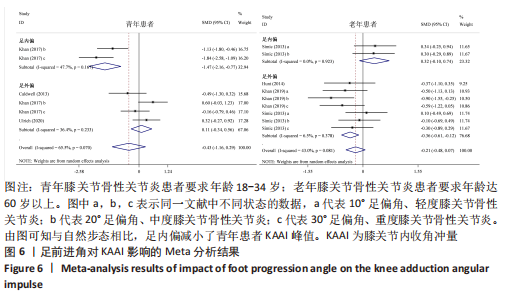
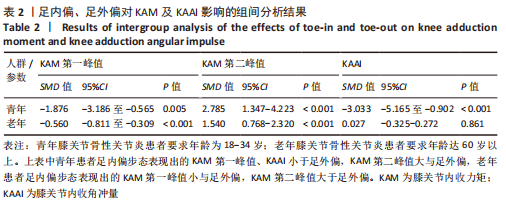
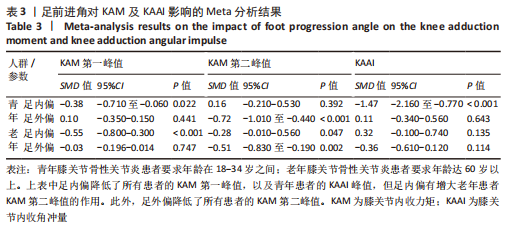
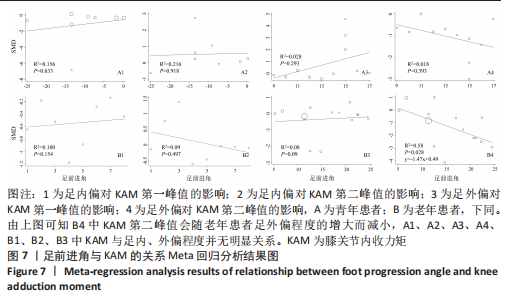

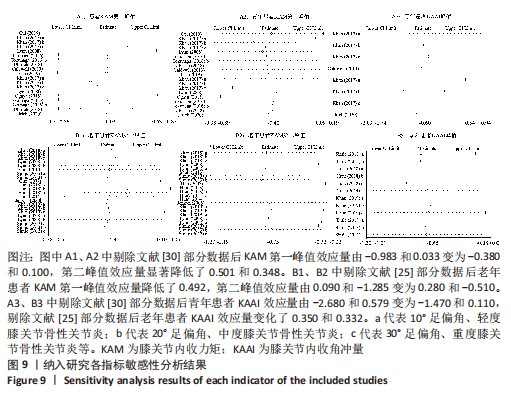
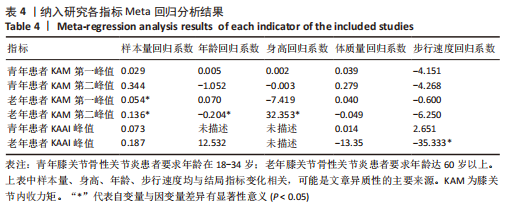
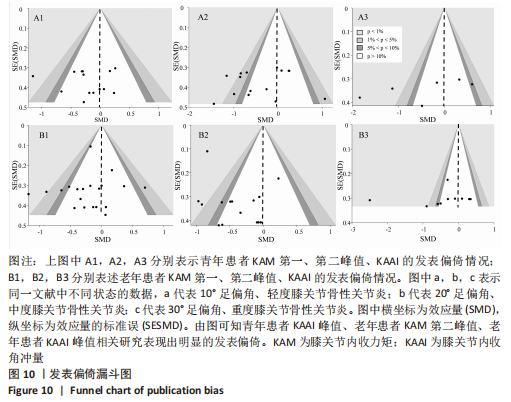
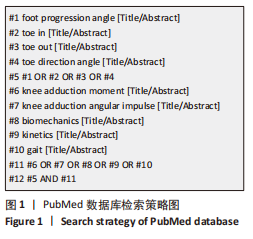
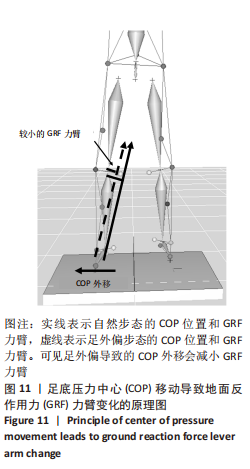 最近的研究发现,老年患者的膝关节骨性关节炎发展速度比青年患者更快,这是由于衰老引起的步态适应增加了KAM、KAAI以及膝关节内侧负荷,再加上促炎症细胞因子明显增加,促进了软骨退化及膝关节骨性关节炎发展的过程[43],所以对老年患者的治疗亦极为重要。文章中,足内偏可减小老年患者步行时的KAM第一峰值,与先前的系统评价研究结果吻合[44],这是由于步行期间的足内旋有助于改善内、外侧腘绳肌的共收缩作用,减轻膝关节内侧负荷并减缓膝关节骨性关节炎发展[31]。LYNN等[31]进一步发现足前进角改变腘绳肌激活的机制可能与胫骨旋转有关,足内偏引起的胫骨内旋有助于预激活内侧腘绳肌,放松外侧腘绳肌,使步行时肌肉的收缩、舒张更为协调,对减少膝关节外部负荷有积极作用。
最近的研究发现,老年患者的膝关节骨性关节炎发展速度比青年患者更快,这是由于衰老引起的步态适应增加了KAM、KAAI以及膝关节内侧负荷,再加上促炎症细胞因子明显增加,促进了软骨退化及膝关节骨性关节炎发展的过程[43],所以对老年患者的治疗亦极为重要。文章中,足内偏可减小老年患者步行时的KAM第一峰值,与先前的系统评价研究结果吻合[44],这是由于步行期间的足内旋有助于改善内、外侧腘绳肌的共收缩作用,减轻膝关节内侧负荷并减缓膝关节骨性关节炎发展[31]。LYNN等[31]进一步发现足前进角改变腘绳肌激活的机制可能与胫骨旋转有关,足内偏引起的胫骨内旋有助于预激活内侧腘绳肌,放松外侧腘绳肌,使步行时肌肉的收缩、舒张更为协调,对减少膝关节外部负荷有积极作用。